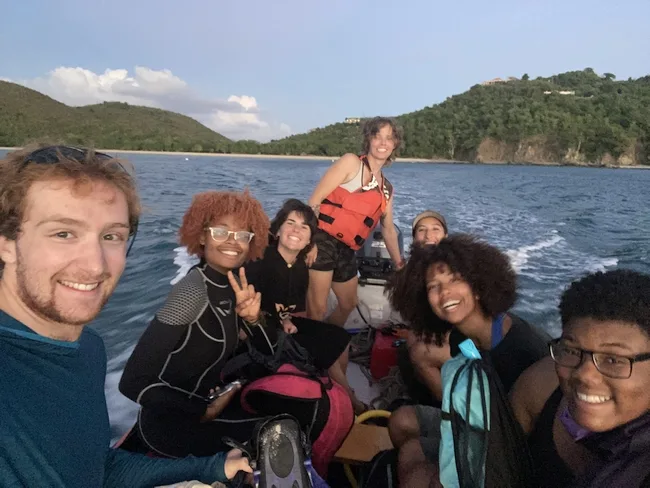News
A Day in the Life of the Ship‘s Engineer

Author: Patrick Robichaud, Operational Engineer
Ship’s Log
Ship’s Position
16°49.597’N x 64°02.161’W
Ship Heading
355
Ship Speed
4.10 knots
Taffrail Log
295 nm
Weather
F5 winds NE, 4ft waves
Location
63 nm SSE of St. Croix
Today I woke up and only saw sea all around me, a first for this trip! The waves are undulating beneath and around the ship. In the main salon the tables are constantly tilted to various degrees to port as we are hove to on a port tack currently while the students are learning how to operate the hydro-winch for science. The rolling motion of the sea is taking some getting used to, as walking in a straight line is impossible. And I have the advantage of having some offshore experience, as a professional crew member, compared to most students who have never felt anything like this. But first let me introduce myself, my name is Patrick and I am the Operating Engineer on the Cramer. In this position I maintain, operate, and fix the ship’s systems including the water, waste-water, electric, and propulsion (engine).
 Sunrise rainbow in Francis Bay, St John
Sunrise rainbow in Francis Bay, St John
Today my morning started at 0115 when Jen, the off-going mate, woke me up because on a boat check, a student smelled something burning/off in dry stores. Dry stores is accessed through the galley and is under the main salon. It is where the water makers, reefer (refrigerator), freezer, and compressors are located. Because we just got offshore I only started making water yesterday. When I went down at 0118 to check the systems they were all operating fine with no issues. I think the smell was from the hot electric motors from the water maker pumps combined with the smell of the food stored down there.
I was woken up again at 0430 by Davi, a deckhand, saying the reefer and freezer are warmer than they should be. I again got up and checked them. For some reason the compressor I had turned on the day before was not keeping them cool so I turned on our other compressor which was working well. I also turned off the water makers so they could cool down for a few hours, as they had been running from noon the day before. When I was done I looked at the stars and checked in with the mate on watch before heading to bed again.
At 0700 I got up for breakfast of hash browns, scrambled eggs, sausage, and oranges. The main generator was due for an oil change so I changed its oil for the first time this trip. I then restarted the water makers and checked on the main engine and deck generator as part of my daily tasks.
By 1030 I was taking a break and eating snack of snap peas and ranch and chatting with the staff and students who are awake. I continued to work on my weekly tasks of checking each of the generators, switching their starting batteries, checking the belts, and updating the operations log.
At 1220 the triangle rang for first lunch and I enjoyed a bowl of pasta salad along with a green salad. I then took a nap before class at 1430.
Class started at 1430 with Captain Kevin doing a check in with all the students and crew using our thumbs. Most people are doing well but a few students are very sea sick and many have minor symptoms. I am lucky to be doing well! Rocky, the Chief Mate, gave our nav report: we traveled 94.4 nm in the past 24 hours from noon, our log run. And we had a rhumb run of 80 nm, or the distance as the crow flies from our position at noon to our position 24 hours before. Bonny, the 1st Scientist gave our science report and we learned about Sargassum. “A” watch had done a neuston net tow this morning so she had a sample of Sargassum in a glass gar that we passed around. In the jar there was a small Sargassum crab which blended in VERY well and a file fish swimming around which was awesome! After these presentations all the students had a Hydro-winch training to get ready for conducting oceanographic research.
Being the engineer I may not have as much direct contact with the students but I still try to involve them in my daily tasks. For example students have been switching power and starting and stopping the generators, which is done twice daily. As the only engineer I am quite busy but I enjoy all my interactions with students and crew along with being able to go on deck and experience the sea all around me.
P.S. Mama and Papa, please pat Touque and Coco for me!
Patrick Robichaud, Operational Engineer
Contact: Douglas Karlson, Director of Communications, 508-444-1918 | dkarlson@sea.edu